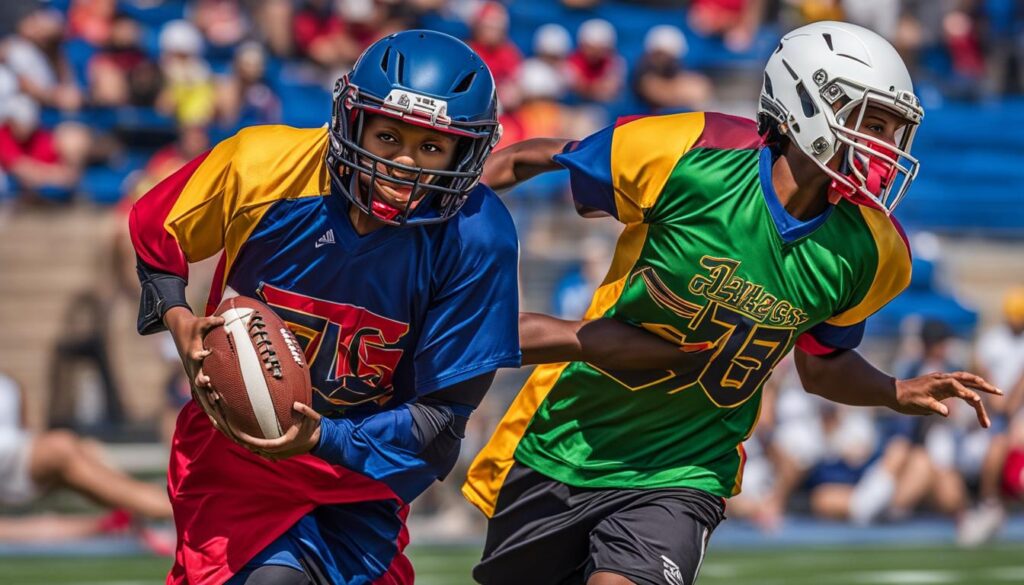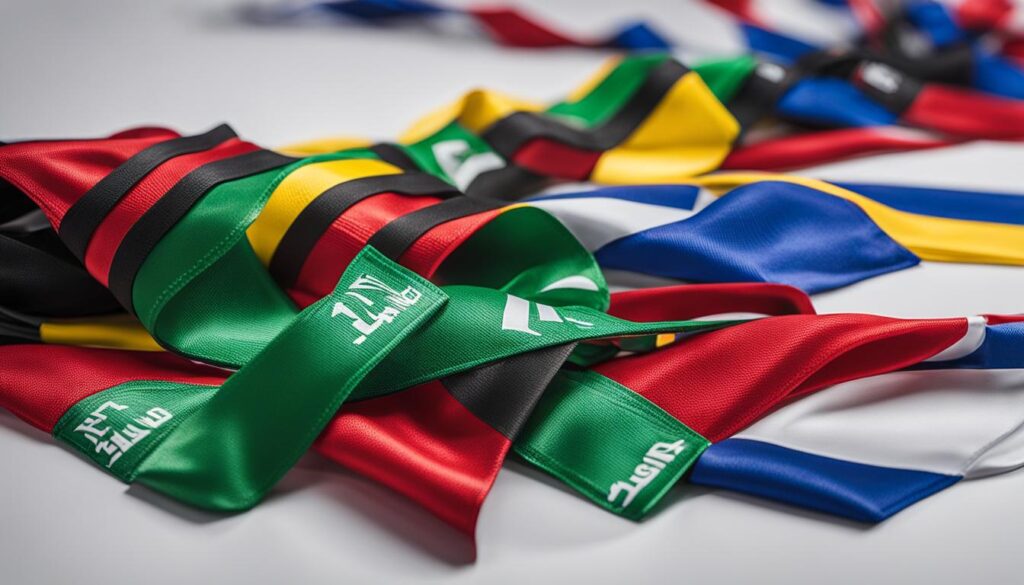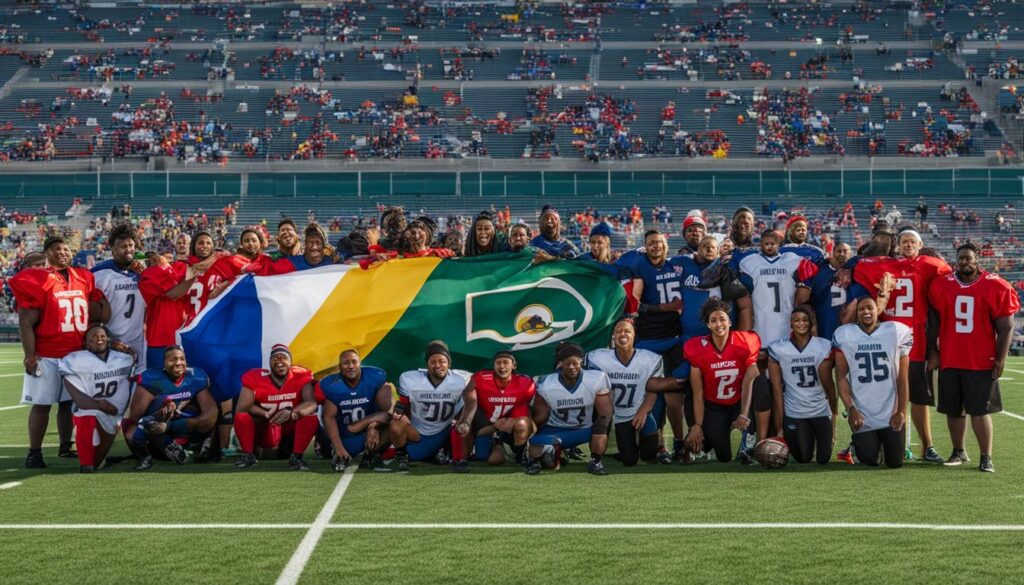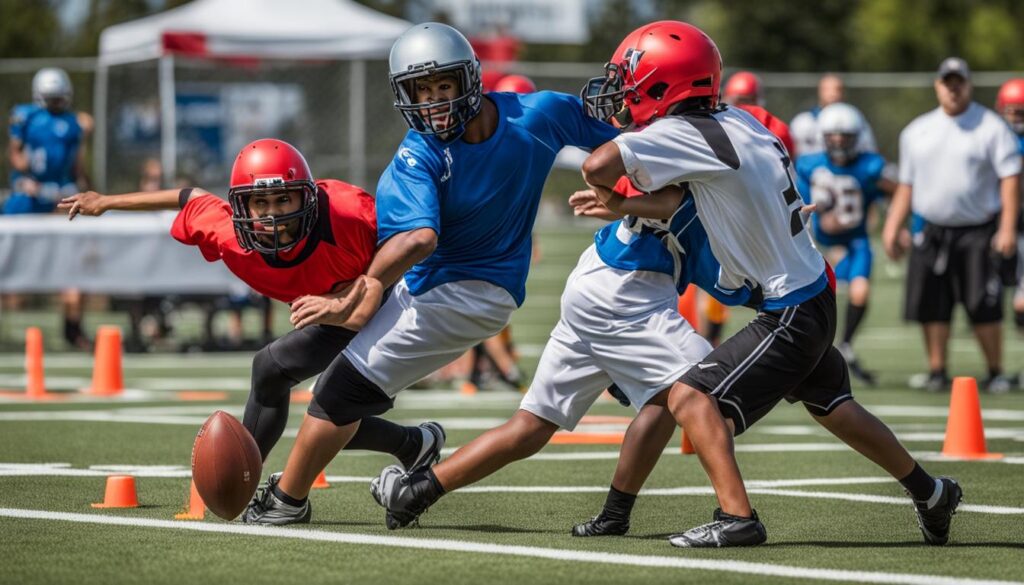In football, one may wonder why players wear flags during the game. These flags play a crucial role in enforcing the rules and maintaining fair play. Through a deep dive into the significance of flags, we can unravel the world behind their existence and understand their importance in the game of football.
To comprehend why football players wear flags, it is essential to explore flag football rules, flag football penalties, and the equipment involved. By understanding these aspects, we gain valuable insights into the game and how these flags impact the overall gameplay experience.
Key Takeaways:
- Flags in football are penalty indicators thrown by referees.
- Understanding flag football rules is crucial to comprehending the game.
- Flag football offers a non-contact alternative to traditional football.
- Flag football promotes inclusivity and equal opportunities for all players.
- The skills gained in flag football are transferable to tackle football.
The Purpose of Flags in Football
Flags in football serve as a universal signal that a team has committed a penalty. They help referees enforce the rules of the game and maintain fair play. When a penalty is called, the referee throws the flag to indicate the infraction. The presence of a flag does not immediately identify which team committed the penalty, as the referee will confer with the official who threw the flag to determine the culprit. The flag serves as a visual indicator for both players and spectators that a penalty has occurred.
Flags play a vital role in football by ensuring that the game is played within the boundaries of the rules. They help maintain the integrity of the sport and ensure that all teams have an equal opportunity to compete. The throwing of a flag is a significant moment in a game, as it can lead to various consequences such as loss of yardage, automatic first downs, or replaying downs. As such, players and coaches must understand the significance of penalty flags and how they impact the flow and outcome of a game.
In addition to their role in enforcing penalties, flags also serve as a visual representation of the game’s integrity. When a flag is thrown, it sends a message to players and spectators that the rules of the game are being upheld and that fair play is paramount. The sight of a flag being thrown can elicit a range of emotions, from frustration to relief, depending on which team it is thrown against. Regardless of the outcome, the presence of a flag adds an element of suspense and drama to the game, heightening the overall spectator experience.
| Significance of Penalty Flags | Purpose |
|---|---|
| Enforce rules | Ensure fair play and maintain game integrity |
| Indicate penalties | Visually signal infractions to players and spectators |
| Determine consequences | Lead to various outcomes such as loss of yardage or automatic first downs |
Overall, the purpose of flags in football is to uphold the rules of the game, maintain fairness, and ensure that all teams have an equal opportunity to succeed. They serve as a visual representation of penalties and add an element of suspense to the game. Understanding the significance of penalty flags is crucial for players, coaches, and spectators alike, as it enhances their overall understanding and enjoyment of the sport.
Pre-Snap Flags in Football
In the world of football, penalties can occur at various points during a play. Pre-snap penalties, as the name suggests, refer to infractions that happen before the center snaps the ball to start the play. These penalties can disrupt the flow of the game and have consequences for the offending team. Let’s take a closer look at some common pre-snap penalties and their impact on the game.
False Starts
A false start occurs when an offensive player moves before the ball is snapped. This can include any movement that simulates the start of the play. False starts often happen due to miscommunication or a lack of concentration, resulting in a five-yard penalty against the offense. The down remains the same, meaning it’s still first down if it was previously first down.
Illegal Formations
An illegal formation penalty is called when the offense lines up incorrectly before the snap. This can include having too many players in the backfield, not having enough players on the line of scrimmage, or an ineligible receiver being positioned in the wrong place. Illegal formation penalties also result in a five-yard penalty, with the down remaining the same.
Delay of Game
If the offense fails to snap the ball before the play clock expires, a delay of game penalty is called. This penalty typically occurs when the offense takes too long to get set and run the play. A delay of game penalty results in a five-yard loss and a down remaining the same, unless the penalty occurs on fourth down, in which case it results in a loss of down.
These pre-snap penalties can be costly for teams, often resulting in loss of yards and potentially affecting their offensive strategy. It’s crucial for players to stay disciplined and focused, ensuring they adhere to the rules and regulations of the game to avoid these penalties.
| Penalty | Definition | Consequence |
|---|---|---|
| False Start | An offensive player moves before the ball is snapped. | 5-yard penalty against the offense. Down remains the same. |
| Illegal Formations | Offense lines up incorrectly before the snap. | 5-yard penalty against the offense. Down remains the same. |
| Delay of Game | The offense fails to snap the ball before the play clock expires. | 5-yard penalty against the offense. Down remains the same, unless it occurs on fourth down, resulting in a loss of down. |
Post-Snap Flags in Football
In football, post-snap penalties are infractions that occur after the ball has been snapped and the play is in motion. These penalties can have a significant impact on the outcome of a game, as they often result in a loss of yardage and a repeat of the down.
One common post-snap penalty is holding, which occurs when an offensive player grabs or restricts a defender, impeding their ability to make a play. Holding penalties result in a loss of yardage and a repeat of the down.
Another post-snap penalty is offensive pass interference, which occurs when an offensive player interferes with a defender’s ability to catch an interception or defend against a pass play. This penalty results in a loss of yardage and a repeat of the down.
Defensive pass interference is another post-snap penalty that can have a significant impact on the game. It occurs when a defensive player interferes with an offensive player’s ability to catch a pass. Defensive pass interference often results in an automatic first down for the offense.
Post-snap penalties are indicated by referees throwing their yellow flags to the spot of the foul. This visual signal alerts players and spectators that a penalty has occurred and helps maintain fairness and integrity in the game.
Holding Example:
“The offensive lineman clearly grabbed the defender’s jersey and prevented them from making a play on the quarterback. This is a clear case of holding and will result in a penalty.”
Defensive Pass Interference Example:
“The cornerback made contact with the receiver before the ball arrived, preventing them from making a play on the pass. This is a defensive pass interference penalty and will result in an automatic first down for the offense.”
Offensive Pass Interference Example:
“The wide receiver pushed off the defender before making the catch, gaining an unfair advantage. This is an offensive pass interference penalty and will result in a loss of yardage and a repeat of the down.”
Table: Post-Snap Penalties in Football
| Penalty | Definition | Consequences |
|---|---|---|
| Holding | Offensive player grabs or restricts a defender | Loss of yardage, repeat of the down |
| Offensive Pass Interference | Offensive player interferes with a defender’s ability to catch or defend against a pass | Loss of yardage, repeat of the down |
| Defensive Pass Interference | Defensive player interferes with an offensive player’s ability to catch a pass | Automatic first down for the offense |
Flag Football: A Non-Contact Alternative
Flag football is a popular non-contact sport that offers a fun and accessible alternative to traditional tackle football. In flag football, players wear flags that hang along their sides by a belt. The objective for the opposing team is to “tackle” the person in possession of the ball by pulling one or both of their flags off. This non-contact aspect of the game eliminates the risk of physical tackles and blocks, making it a safer option for players of all ages and skill levels.
Flag football rules are designed to prioritize player safety while still providing a fast-paced and engaging game. Unlike tackle football, where physical contact is a fundamental part of the sport, flag football focuses on skill, strategy, and teamwork. By removing the element of physicality, flag football encourages players to rely on their agility, speed, and coordination to succeed on the field.
In addition to being a non-contact sport, flag football holds several benefits. It promotes inclusivity by offering equal opportunities for both male and female athletes. It also allows players to develop essential football skills such as throwing, catching, and running routes while honing their knowledge of offensive and defensive strategies. Flag football is an excellent way for beginners to learn the fundamentals of the game in a less intimidating environment.
The Benefits of Flag Football:
- Provides a non-contact alternative to tackle football
- Promotes player safety and reduces the risk of injuries
- Encourages skill development in throwing, catching, and running routes
- Promotes teamwork, strategy, and coordination
- Offers equal opportunities for male and female athletes
- Introduces beginners to the fundamentals of football in a less intimidating environment

Flag football is a fantastic option for those who want to enjoy the excitement of football without the physicality of traditional tackle football. Whether you’re looking to play a recreational game with friends or participate in a competitive league, flag football offers a safer playing experience while still providing all the thrills and challenges of the game. So grab your flags, hit the field, and experience the joy of flag football!
Basic Flag Football Rules
Flag football has specific rules that differ from traditional tackle football. These rules prioritize player safety and ensure a non-contact playing experience. Here are some of the basic flag football rules to keep in mind:
Forward Passes Only
In flag football, all passes must be thrown forward and received beyond the line of scrimmage. This rule promotes an exciting and dynamic passing game, requiring receivers to create separation from the defenders and make successful catches downfield.
Direct Handoffs
Unlike lateral passes or pitches in tackle football, only direct handoffs are permitted in flag football. This rule encourages quick and efficient ball exchanges between the quarterback and running back, minimizing the risk of turnovers and promoting effective running plays.
No Contact Allowed
As the name suggests, flag football prohibits any form of physical contact between players. Instead of tackling an opponent, defenders aim to remove one or both of the ball carrier’s flags to signify a “tackle.” This rule ensures a safe and inclusive playing environment for all participants.
By following these basic flag football rules, players can enjoy a fast-paced and engaging game while maintaining a focus on skill, strategy, and sportsmanship.
Flag Football Equipment and Safety Guidelines
Flag football is a sport that prioritizes safety while still providing a thrilling and engaging experience for players of all ages. To participate in flag football, players require minimal equipment compared to traditional tackle football. The primary piece of equipment is the flag worn by players, which is typically attached to a belt. The flags are easily removable when “tackled” by opponents, allowing the game to progress without physical contact. Additionally, a standard football is used for gameplay, ensuring that the fundamental skills of the sport are still practiced.
When it comes to safety in flag football, there are guidelines that players should follow to minimize the risk of injuries. First and foremost, it is important to ensure that flags are securely fastened to the belt to prevent unintentional removal during gameplay. This ensures fair play and avoids any potential disputes regarding tackles. Secondly, the use of properly inflated footballs is crucial to maintain the integrity of the game. Overly deflated or overinflated footballs can affect the accuracy and safety of throws and catches. Lastly, practicing good sportsmanship is essential to promote a positive and safe environment for all players.

Flag Football Equipment Checklist:
- Flag belt with securely attached flags
- Properly inflated football
Safety Guidelines:
- Ensure that flags are securely fastened to the belt
- Use properly inflated footballs
- Practice good sportsmanship
The Benefits of Playing Football
Playing football offers numerous benefits for individuals, contributing to both their physical and mental well-being. Whether it’s tackle or flag football, the sport provides a platform for individuals to enhance their physical health, learn valuable life skills, and foster social connections.
Improved Physical Health
Football is a physically demanding sport that requires players to engage in aerobic and anaerobic activities. Participating in regular football games and practices helps improve cardiovascular health, increase stamina, and build strength. The constant movement, quick bursts of speed, and agility required in football contribute to improved overall fitness.
Development of Teamwork and Discipline
Football is a team sport that emphasizes the importance of working together towards a common goal. Playing football helps individuals develop crucial teamwork skills such as communication, cooperation, and trust. Additionally, the sport instills discipline in players, teaching them the value of practice, dedication, and perseverance in achieving success both on and off the field.
Mental Toughness and Social Skills
Football challenges players both mentally and emotionally, fostering mental toughness and resilience. It teaches individuals to handle pressure, overcome setbacks, and stay focused in high-stress situations. Moreover, football provides an opportunity for social interaction and the development of social skills. Team members build friendships, learn to respect and support one another, and develop effective communication skills.
Overall, playing football, whether in its tackle or flag form, offers a range of benefits that go beyond the field. From improving physical health and promoting teamwork to cultivating discipline and mental toughness, the sport provides individuals with valuable skills and experiences that extend beyond the game itself.
Inclusivity in Flag Football
Flag football is an accessible sport that promotes inclusivity and provides equal opportunities for players of all abilities and backgrounds. One notable area of inclusivity in flag football is the rise of female flag football, which has gained significant popularity in recent years. With the emergence of women’s flag football leagues and college-sanctioned competitions, female athletes now have a platform to showcase their skills and compete at a high level.
This increased focus on female flag football not only offers a space for women to participate in the sport but also helps to break down gender stereotypes and barriers. It promotes gender equality in sports and encourages girls and women to pursue their passion for football, fostering a sense of empowerment and community.
Flag football is an accessible sport for both genders, as it does not require heavy equipment or physical contact. The use of flags instead of tackling allows players of all ages and skill levels to participate and enjoy the game without the fear of injury. This accessibility extends beyond gender inclusivity and encompasses individuals with diverse abilities, offering a safe and inclusive environment for everyone.
With its emphasis on inclusivity and accessibility, flag football provides a welcoming space for individuals to engage in sport, build relationships, and develop valuable skills. Whether on the field or off, flag football fosters a sense of belonging and camaraderie, creating a supportive community that celebrates diversity.

Flag Football vs. Tackle Football
Flag football and tackle football are two versions of the same beloved sport, each with its own unique characteristics. While flag football eliminates physical contact, tackle football embraces the full-contact nature of the game. Despite these differences, there are several transferable skills that players can develop in flag football that directly translate to tackle football.
Fundamentals: Both flag football and tackle football emphasize the importance of mastering fundamental skills. In flag football, players focus on catching, throwing, running routes, and defensive techniques. These skills form the building blocks of the game and help players develop the necessary agility, coordination, and spatial awareness required in both versions of football.
Speed of Play: Flag football is renowned for its fast-paced and high-scoring nature. The absence of physical contact allows for a quicker tempo, as players can quickly transition from offense to defense. This speed of play helps players develop their decision-making abilities, their ability to read the game, and their overall football IQ. These qualities are invaluable in tackle football, where split-second decisions can make all the difference on the field.
| Flag Football | Tackle Football |
|---|---|
| Emphasizes fundamental skills | Develops physicality and tackling techniques |
| Leads to quick decision-making | Fosters strategic thinking and complex game plans |
| No physical contact | Full-contact sport |
Although flag football and tackle football have their own distinct nuances, the skills learned and honed in flag football can be directly applied to tackle football. The fundamental techniques and quick decision-making developed in flag football provide a solid foundation for players transitioning to tackle football. Whether it’s the fluidity of movement, the precision of passing, or the strategic awareness, flag football equips players with the necessary tools to succeed in the tackle version of the game.

Flag Football: Fun and Easy to Play
Flag football is a sport that brings together the excitement of football without the physical contact. It offers a fun and accessible experience for players of all ages and skill levels. One of the main advantages of flag football is its focus on fun and enjoyment, making it a great choice for recreational players and those looking for a less intense version of the game.
In addition to being fun, flag football is also highly accessible. With minimal equipment required, such as flags and a football, it is easy for anyone to get started. Unlike tackle football, there is no need for heavy pads and helmets, which can be a deterrent for some people. This accessibility makes flag football a popular choice for both children and adults who want to enjoy the sport in a more relaxed and inclusive setting.
Another aspect that makes flag football appealing is the lower commitment level compared to traditional tackle football. Practices and games are usually scheduled once per week, allowing players to participate without overwhelming their schedules. This makes it an ideal option for individuals with busy lifestyles or those who are looking for a recreational activity that still offers the thrill of competition.
Flag football games are known for their quick pace and high engagement. With fewer players on the field, the action moves swiftly, keeping players involved and entertained throughout the game. The fast-paced nature also means that games can be completed in a shorter amount of time, making it an ideal choice for those who want to fit in a quick and exciting sport session.
Benefits of Flag Football:
- Fun and enjoyable playing experience
- Accessible for players of all ages and skill levels
- Minimal equipment required
- Lower commitment level compared to tackle football
- Quick games with high engagement
Conclusion
Football players wear flags as a visual indicator of penalties committed during the game. In flag football, the use of flags replaces physical contact, making it a safer alternative without compromising the excitement and competitiveness of the sport. By understanding the rules, benefits, and inclusivity of flag football, players of all ages and abilities can enjoy the game while developing valuable skills and nurturing a love for football.
Flags in football serve as a universal signal that a team has committed a penalty. These yellow nylon flags, filled with sand weights, are thrown by referees when they spot a penalty. In flag football, players wear flags that hang along their sides by a belt, and the objective is to “tackle” the ball carrier by pulling one or both of the flags off. This non-contact version of football provides a fast-paced and engaging game, promoting safety while still allowing players to experience the thrill of competition.
Flag football offers numerous benefits, both physical and mental. It improves cardiovascular health, enhances coordination, and builds strength. Additionally, it teaches valuable life skills such as teamwork, discipline, and mental toughness. Flag football is an inclusive sport that welcomes players of all abilities and backgrounds, providing equal opportunities for female athletes as well. With its transferable skills and enjoyable gameplay, flag football serves as an accessible and enjoyable entry point to the world of football.
In summary, the use of flags in football signifies penalties, while in flag football, flags replace physical contact for a safer playing experience. By embracing the rules, benefits, and inclusivity of the sport, players can not only develop their skills but also foster a love for football. So whether you’re a seasoned player or new to the game, flag football offers an exciting and enjoyable way to take part in this beloved sport.
FAQ
Why do football players wear flags?
Football players wear flags in flag football to replace physical tackles. The flags hang along their sides and opponents must pull one or both flags off to “tackle” the player with the ball.
What are the penalty flags used for in football?
Penalty flags in football are used by referees to indicate that a team has committed a penalty. They help enforce the rules of the game and maintain fair play.
What are some common pre-snap penalties in football?
Common pre-snap penalties in football include false starts, illegal formations, delay of game, and too many players in the huddle.
What are some post-snap penalties in football?
Post-snap penalties in football can include holding, offensive pass interference, defensive pass interference, and roughing the passer, among others.
What are the basic rules of flag football?
In flag football, all passes must be forward and received beyond the line of scrimmage. Only direct handoffs are permitted, with no laterals or pitches allowed. The quarterback has a seven-second pass clock to get rid of the ball and cannot run with the ball unless it was handed off first.
What equipment is used in flag football?
The primary equipment used in flag football includes flags worn by players and a football. The flags are typically attached to a belt and are easily removable when “tackled” by opponents.
What are the benefits of playing football?
Playing football improves cardiovascular health, enhances hand-eye coordination, builds strength, and teaches valuable life skills such as teamwork, discipline, and mental toughness.
Is flag football an inclusive sport?
Yes, flag football is an inclusive sport that welcomes players of all abilities and backgrounds. It provides equal opportunities for female athletes and offers a less intimidating introduction to the sport.
Do the skills learned in flag football transfer to tackle football?
Yes, the basic fundamentals and skills taught in flag football directly transfer to tackle football. The focus on catching, throwing, formations, and defensive techniques in flag football lays the foundation for tackling and more advanced strategies.
Is flag football fun and easy to play?
Yes, flag football is a fun and accessible sport that requires minimal commitment. With fewer safety concerns and less equipment, players can enjoy the game without heavy pads and helmets. Practices and games are usually scheduled once per week, making it easier to fit into busy schedules.
